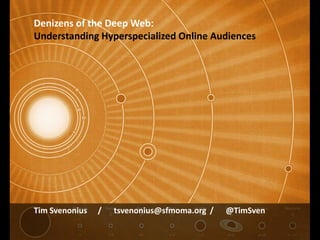
Understanding Hyperspecialized Online Audiences at SFMOMA
- 1. Denizens of the Deep Web: Understanding Hyperspecialized Online Audiences Tim Svenonius / tsvenonius@sfmoma.org / @TimSven
- 2. Denizens of the Deep Web: Understanding Hyperspecialized Online Audiences
- 4. The Surveys: 1. Open Space format: blog established: 2009 frequency: daily
- 5. The Surveys: 2. SFMOMA Artcasts format: podcast series established: 2005 frequency: 6 per year
- 6. The Surveys: 3. Multimedia survey invitation appeared when users clicked on video, audio, interactive features, etc.
- 7. Three Online Audience Surveys Open Space 299 surveys completed 180 were repeat visitors; 16 were interviewed Multimedia 655 surveys completed SFMOMA Artcasts 169 surveys completed 52 were repeat listeners; 12 were interviewed
- 8. Q: How Many Times a Year Do You Visit SFMOMA? n = 180 n = 655 n = 52 question included in all three surveys.
- 9. Q: Where Do You Live? n = 180 n = 655 n = 52 question included in all three surveys.
- 10. Q: Are You a Member of SFMOMA? n = 180 n = 655 n = 52 question included in all three surveys.
- 11. Q: What is Your Age? question included in all three surveys.
- 12. Q: What is Your Education Level? question included in all three surveys.
- 13. Q: What is Your Annual Household Income? question included in all three surveys.
- 14. Q: Who Do You Want to Hear From? question included in the multimedia survey; n = 655
- 15. Q: Who Do You Want to Hear From? question included in the multimedia survey; n = 655
- 16. Q: Who Do You Want to Hear From? question included in the Artcast survey; results shown are repeat listeners. n = 56
- 17. (or, who don’t you want to hear from?) question included in the Artcast survey; results shown are repeat listeners. n = 56
- 18. Q: Who Do You Want to Hear From? question included in the Artcast survey; results shown are repeat listeners. n = 56
- 19. What Subject Matter Do You Like? question included in the Artcast survey; results shown are repeat listeners. n = 56
- 20. Outcomes and Conclusions / Hard Questions and Contradictions Tim Svenonius / tsvenonius@sfmoma.org / @TimSven
Editor's Notes
- The concentric orbit model: a museum at the center of the solar system, and very tight orbits = members and frequent visitors. Then outside that, perhaps there are the infrequent visitors, and maybe the online visitors who only seldom make it through the front door, but never the less are loyal followers.
- One of the audiences I’m particularly interested in is the podcast user. It is inherently very difficult to know anything about podcast listeners. By design, a podcast is a piece of media that gets downloaded to a portable device for later use. Once it’s downloaded, we have no idea what happens to it. Furthermore, because of the way subscriptions work—listeners might subscribe through iTunes or an RSS aggregator—they never have to come to our website. So somewhere out here in the distant reaches of the solar system, we have our podcast listeners.
- We conducted three different online audience surveys. The first was for Open Space, the museum’s blog. It turned three years old this year and underwent a redesign. The Open Space readership is very active and a relatively close-knit group.
- The second survey was for the Artcast, which was launched in 2005, and has undergone some evolution. Early on it was released every month, then we went to every six weeks, and now we release an episode every two months. But as I said, we have very little idea of who hears it, how they consume it, and what they think.
- Lastly we conducted a survey of general multimedia users. So for a couple of weeks, if you went to a video, audio, podcast, or interactive feature on our site, you would get a prompt asking you to take the survey. If you took the survey you could win a brand new iPad.
- It’s possible that we do know something about these online visitors based on the fact that some of them also visit our museum in person. Of the respondents to the multimedia and artcast surveys, more than a quarter of them say they’ve never visited our museum. And we see a substantial disparity between that and the Open Space readership, about two-thirds of whom visit three or more times per year!
- Match that up with this measure, where do you live? We can see that Open Space is overwhelmingly local and loyal visitors.
- The big grey area here means I’ve never been a member.
- Like our onsite visitors, the web users overwhelmingly have graduate degrees. Based on other polls and surveys, these are not necessarily art-related graduate degrees.
- The general age of the blog readers is considerably lower than what we see in our general multimedia traffic. The podcast listeners are somewhere in between.
- This shows the data from the previous slide with the “love” and “like” greyed out.
- Again, the previous chart, but removing the “love” and “really like”.
- Here’s a situation in which we reserve a little skepticism for the data. Do the listeners know which artists we consider local? We always aim to provide the richest possible material, without necessarily discriminating between the world-famous and local stars. And I think that our listeners would usually not care either; they like good stories about interesting art.